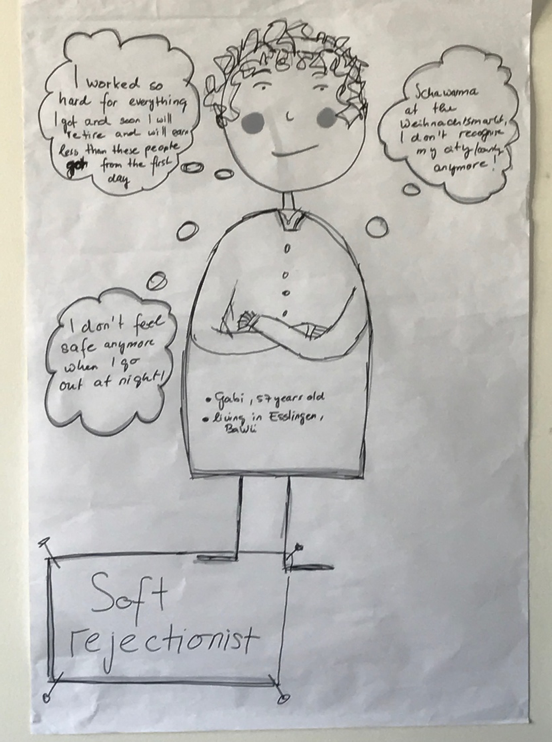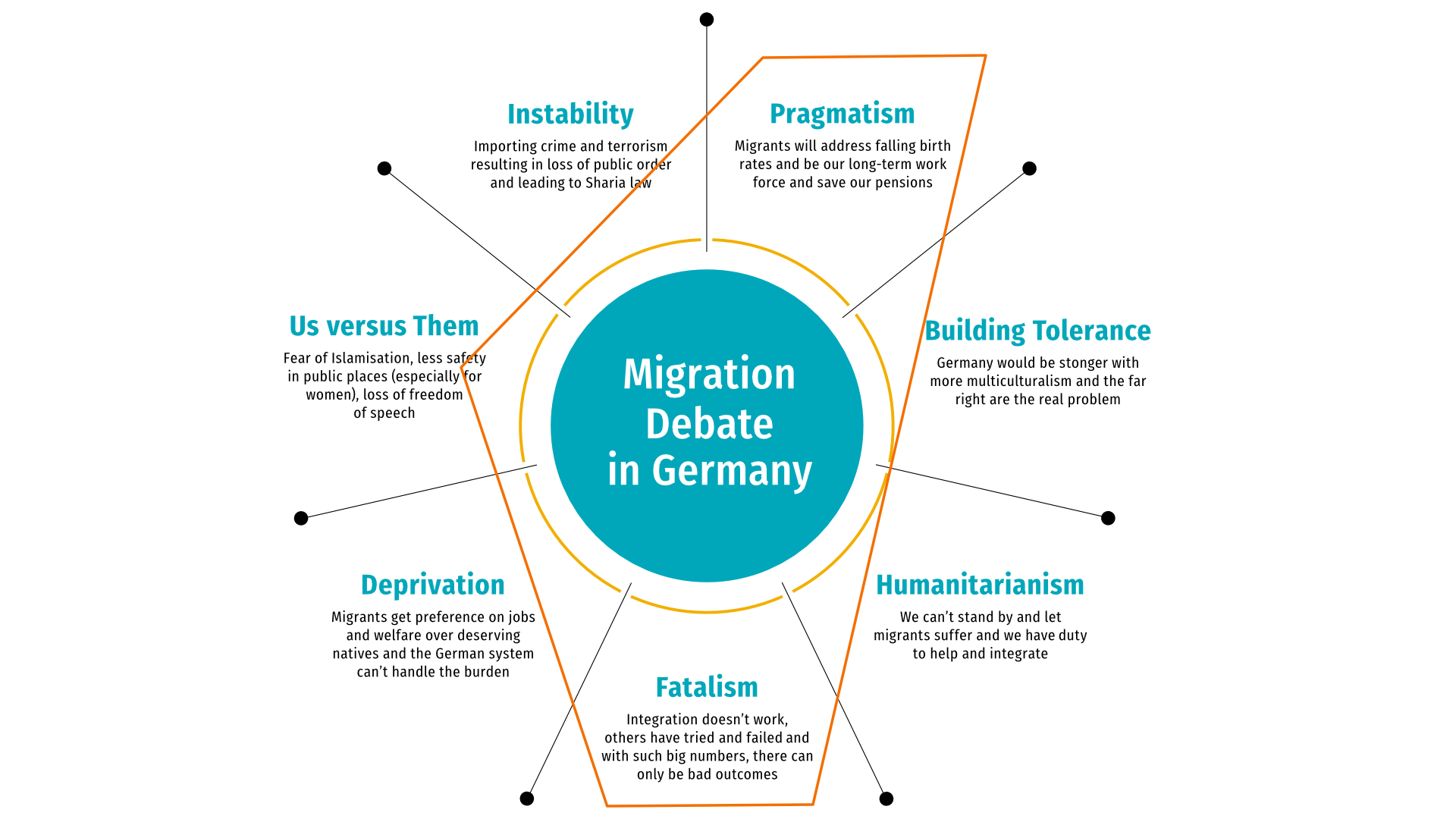1.1 Target middle segments & their current frames
The first step of the narrative change planning process – Find a focus and opening – consists of five elements that guide you in the development of a campaign strategy. On this page, we focus on the first element - Target middle segment(s) & current frames/positions.
-
Target middle segments & their current frames
-
Positive value map
-
Narrative space for your campaign
-
Opportunity or opening
-
Feasible campaign objectives
In order to identify a specific segment(s) of the middle to target in your campaign, it’s important to start by understanding who the middle are in your context and how they currently discuss the issue of migration. So, building on our definition of the middle and the discussion at the opening of Step 1, we suggest a research-based approach, centred around the four tasks fleshed out below to get the depth needed to build a focused campaign.
Use segmentation/polling research to get a better understanding of the middle in order to decide who to broadly target for campaigns
To make a start on your campaign work, you obviously need to know more of the specifics on the middle segments that could be potential targets for your campaign. A key source of this information is polling research designed to understand the whole debate and parsed in segments.
Our partners, More in Common and Social Change Initiative, conducted such a study of the German population (see below in figure 1) in which five segments were identified. In consultation with our German network, we think that two of the identified segments provide the best opportunity as ‘movable’ segments – Economic Pragmatists and Humanitarian Sceptics1 . Hence, these are the broad targets for the campaigns we are supporting with German partners in our Narrative Change Lab.

The segmentation approach provides an in-depth insight into attitudes on key migration issues, clusters them according to these opinions, and then also gives a profile of each group. An overview of the profile the study provides for our two target middle groups is as follows:
Economic Pragmatists:
- 20% of the population
- Proud to identify as German
- Positive about the future
- Believe that immigration makes Germany more open to new ideas and cultures
- Concerned about the chances to integrate Muslims and don’t think refugees should stay permanently
- Mostly CDU/CSU, SPD voters
Humanitarian Sceptics:
- 23% of the population
- See accepting refugees as an obligation, but have reservations and conflicted feelings
- Think other Europeans should carry the load more
- Doubts about successful integration
- Older sections of society
- Mostly CDU/CSU, FDP and Die Linke voters
The added value of having this breakdown of middle segments is that progressive campaigners move beyond the temptation to lump all those who aren’t strongly pro-migrant into one group of ‘opponents’. In turn, this more nuanced and deeper insight and clarity on target audiences helps campaigners to be more strategic from the start in the campaign development process, especially in developing targeted messages which have a good potential of resonating with the middle.
More of this kind of segmentation research is publicly available for mainly European countries, especially from our partners More in Common and Social Change Initiative.
Listen also to Frank Sharry from America's Voice on his key lessons on reaching out to the middle:
Personify and try to understand the middle as people
While polling and segmentation research are a necessary starting point, it is also important to understand the middle as people. In narrative change campaigns, we are trying to connect with people to make them feel something different, so the starting point has to be understanding the target audiences emotionally and rationally. We have experienced that this demystifying process makes the campaign development task much easier and more effective if you have a person(s) in mind rather than just an abstract concept, such as the ‘middle’, and we offer some practical suggestions for this personification process:
- In our workshops, we ask participants to unpack the segments and give names to the people in each segment, profile them and even draw them (see Gabi in Figure 2 who is a personification of the Soft Opponents segment in Germany, generated in an Narrative Change Lab workshop in Berlin, December 2017).
- We also do a number of role plays to help participants begin thinking about engaging those in the segment and ask participants to step into the shoes of the middle by taking on the roles of people from the target segments and also of campaigners.
- Many campaigners we work with report that they have begun to listen and engage more with those around them who are part of the middle group. They are often our neighbours, parents, relatives or people sitting opposite you on a train and instead of getting annoyed by their opinions, it is useful for your planning to ask open questions and listen to their concerns more, as well as challenging them!

Figure 2: “Gabi” - Personification of the Soft Rejectionist segment
While many of our participants found this personification process challenging in the beginning – unsurprisingly, as they find the views of many in the middle quite challenging - over time, it does get easier. And participants reported that they can more easily get into the mind-set of the target audience by putting themselves in their shoes and so understand more easily what may resonate with them in campaigns. Our key principle in these type of activities is that understanding does not equal agreement. But understanding is absolutely key if you are to build a campaign that can achieve the aim to be emotionally smart in engaging this middle segment.
Understand the current positions and frames of the target middle segment(s)
The ultimate strategy in narrative change campaigns is to reframe the debate by first, linking to something recognisable and understandable for your target segments, thereby establishing familiarity and reassurance, before then challenging their current thinking in an emotionally smart way. In order to make that first link, campaigners need a deep understanding of the positions, arguments, frames and triggers that inform the current thinking of the target middle segments in the migration debate.
These insights can be collected and extracted from the polling and segmentation research mentioned above, but if you are lucky enough to have access to a frames map of the debate in your country, this is a useful way to triangulate data and have a clearer idea of what is driving the positions that target segments hold. A frames map is an analysis of the most common narratives that occur in the debate and also elaborates the values and lines of argument behind these narratives2 . These can be produced from discourse analysis of various kinds and we commissioned a social media analysis which we used as a basis to produce our frames map of the German debate (See figure 3 below).
If a frames map is available, it is useful to connect the segments to the frames. For example, for the Economic Pragmatists in the German debate, the orange box is an outline of the key frames that inform their positions:

It’s immediately clear from this mapping exercise which areas you could target and what to avoid if Economic Pragmatists were your target segment. Ultimately, it provides a very useful starting point in considering how to connect your messages to the segment.
Choose an initial target segment or segments to target in the campaign
Through an analysis and discussion of the research and the personification process, this leads most campaigners to a consideration of who you would want to engage in the middle. This is the time to make some choices! The research is often done at a national level, but for example you may want to target a specific region or city, so understanding the demographic and voting patterns of your target region can help you to understand the segment breakdown of the potential target.
Step 1.1 Target middle segments & their current frames
-
What is the profile of the middle segments in the migration debate in your context?
-
What names would you give to the various segments of the middle? Does research already exist to support that?
-
What kinds of lives do people in the middle segments live? Do you personally know people who are in these segments? Work to develop a more human profile of those in the middle.
-
What are the main themes or arguments that those in the middle use in the migration debate? What are the values behind these positions?
-
Which segment(s) of the middle are the best target audience for your campaign?
- 1More in Common (2017) Attitudes Towards National Identity, Immigration, and Refugees in Germany.
- 2 Examples of framemaps - FrameWorks Institute (2014) Finish the Story on Immigration: A FrameWorks Multi-Media Message Memo , Crawley, H., McMahon, S. & Jones, K. (2016) Victims and Villains: Migrant Voices in the British Media. Centre for Trust, Peace and Social Relations, Coventry University.